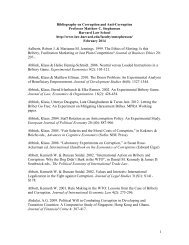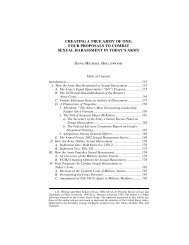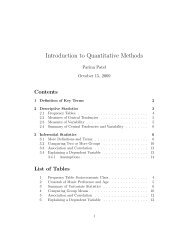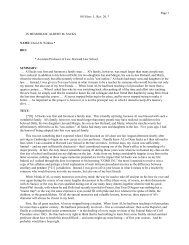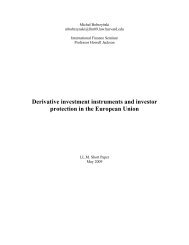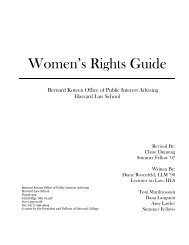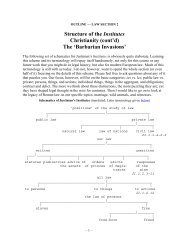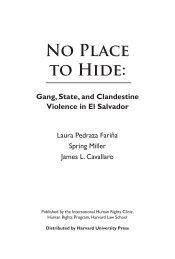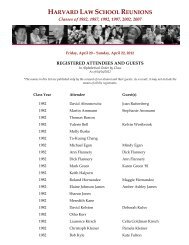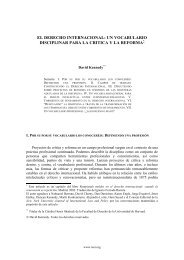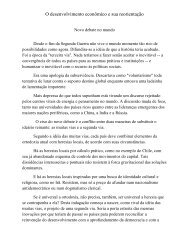Internationale Handelsgesellschaft, Nold and the New Human ...
Internationale Handelsgesellschaft, Nold and the New Human ...
Internationale Handelsgesellschaft, Nold and the New Human ...
You also want an ePaper? Increase the reach of your titles
YUMPU automatically turns print PDFs into web optimized ePapers that Google loves.
Of course <strong>the</strong> court did not explicitly announce a new rationalist human rights paradigm<br />
that authorized it to sit as <strong>the</strong> ultimate arbiter of <strong>the</strong> EU’s policies using proportionality as<br />
a general conceptual framework to structure its policy assessment. As is often <strong>the</strong> case<br />
when courts make <strong>the</strong>ir most innovative decisions, <strong>the</strong> ECJ too relied on <strong>the</strong> most<br />
conventional <strong>and</strong> unassuming concepts <strong>and</strong> arguments to justify its innovation: It was<br />
doing no more than to recognize human rights as general principles of EC law. And it<br />
would do so drawing inspiration from <strong>the</strong> common constitutional tradition of Member<br />
States <strong>and</strong> any international obligations <strong>the</strong>y had signed up to. This is <strong>the</strong> ECJ’s sources<br />
formula: General principles, common constitutional traditions, international Treaty law.<br />
Sources abound, legal guidance <strong>and</strong> constraint is assured, <strong>and</strong> a complex, novel but<br />
ultimately not unfamiliar legal field is established. But even though <strong>the</strong> sources formula<br />
is endlessly repeated by <strong>the</strong> ECJ, <strong>and</strong> has since <strong>the</strong> Treaty of Amsterdam been formally<br />
entrenched in EU Law, it is misleading in more ways than one. Sources of law have had a<br />
negligible role to play in guiding or constraining <strong>the</strong> Court’s human rights jurisprudence<br />
<strong>and</strong> are unlikely to play a much more important role in <strong>the</strong> future.<br />
The first point is that human rights in <strong>the</strong> jurisprudence of <strong>the</strong> court are not conceived of<br />
as discrete set of reasonably specific rules or principles, each of which needs to be traced<br />
to a particular source. Instead <strong>the</strong> issue is to find a ‘source’ for <strong>the</strong> one abstract principle<br />
that <strong>the</strong>n serves as <strong>the</strong> foundation for all fur<strong>the</strong>r explication of human rights by <strong>the</strong> court.<br />
To illustrate <strong>the</strong> point, this is how <strong>the</strong> Advocate General framed <strong>the</strong> issue in International<br />
<strong>H<strong>and</strong>elsgesellschaft</strong>: All rights related questions “concerning <strong>the</strong> internal legality of <strong>the</strong><br />
disputed measures are linked to one <strong>and</strong> <strong>the</strong> same problem, namely whe<strong>the</strong>r or not <strong>the</strong>se<br />
measures comply with a principle of ‘proportionality’, under which citizens may only<br />
have imposed on <strong>the</strong>m, for <strong>the</strong> purposes of <strong>the</strong> public interest, obligations which are<br />
strictly necessary for those purposes attained.” This leads to one central question: “But a<br />
prior question is immediately raised, as to what legal source this principle must be taken<br />
in order to be applied against a measure issued by <strong>the</strong> Community authorities.” 11 The<br />
task, as <strong>the</strong> Advocate General frames it, is to search for a source of a principle that is so<br />
11 See Opinion of Mr. Du<strong>the</strong>illet de Lamo<strong>the</strong>, Case 11/70 p. 1146.



